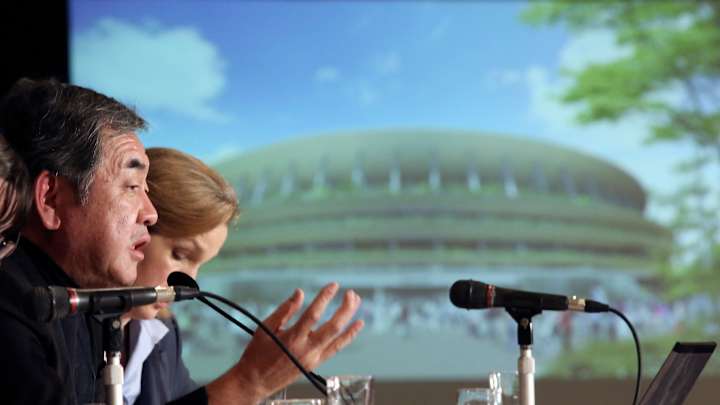Architect of Tokyo 2020 stadium says his design not a copy

TOKYO (AP) Kengo Kuma, the architect of Japan's new 2020 Olympics stadium, refuted allegations by British-Iraqi designer Zaha Hadid that his design borrowed from blueprints she made and which organizers dropped last year.
''In the design, I would like to say there are no similarities at all,'' Kuma told reporters when asked Friday about complaints by London-based Zaha Hadid Architects over apparent similarities between her design and Kuma's.
Kuma noted, however, that both architects had to meet strict specifications for the new, 80,000-seat structure in downtown Tokyo that will replace Japan's old National Stadium.
''The conditions set for the competition mean that automatically some similarities emerge,'' he said. He added that ''the concept is completely different, so it is absolutely a different building, despite the similarities.''
Hadid's company on Thursday said that the Japan Sport Council was withholding money owed for work on the 2020 Tokyo stadium design, while demanding her company give up claims to copyrights.
After her original design was rejected as too costly, Hadid complained the new design chosen by the sport council, made by Kengo Kuma & Associates, in collaboration with two companies that earlier worked with her team, was similar.
Her office said it submitted a report to the sport council detailing the similarities in ''the structure, layout and numerous elements'' between her design and the newly picked one replacing hers, demanding copyright negotiations.
Kuma said he could not comment on those discussions.
He said he did not think that the Japan Sport Council had decided against working with Hadid because she was a foreigner, though working in Japan as a non-Japanese might be challenging.
''I don't know, as I've never worked as a foreigner here,'' said the star architect, who has studied and taught in the U.S. and whose work is in demand around the globe. ''But from my personal point of view, communicating and holding meetings might be difficult.
''Japan needs to work harder to really open its doors to make it a more welcoming environment for people from other countries to work in.''
Hadid's complaints are the latest hiccup for the Olympics effort in Tokyo after the Sport Council abandoned her design and commissioned a less costly and controversial structure. Olympic organizers are still seeking a new logo design after complaints of plagiarism.
Though he earlier joined other renowned Japanese architects in criticizing the initial plan to spend 252 billion yen ($2.1 billion) on Hadid's design, Kuma described her as a ''wonderful architect,'' saying her design ''was an excellent one that uniquely represents her philosophy.''
Kuma's plan is expected to cost 153 billion yen ($1.26 billion) to design, build and maintain, and he said his team intended to meet its cost and time requirements.
He said his wooden lattice design, which echoes traditional styles seen in shrines and pagodas, was intended to blend in with the surrounding parkland and is adapted to minimize costs for heating and cooling the open-air stadium.
The structure will use Japanese-grown larch in its wood and steel composite roof and prefabricated panels to help speed the work along and contain costs, he said.
---
Follow Elaine Kurtenbach: www.twitter.com/ekurtenbach Her work can be found at http://ap.bigstory.org/content/elaine-kurtenbach
